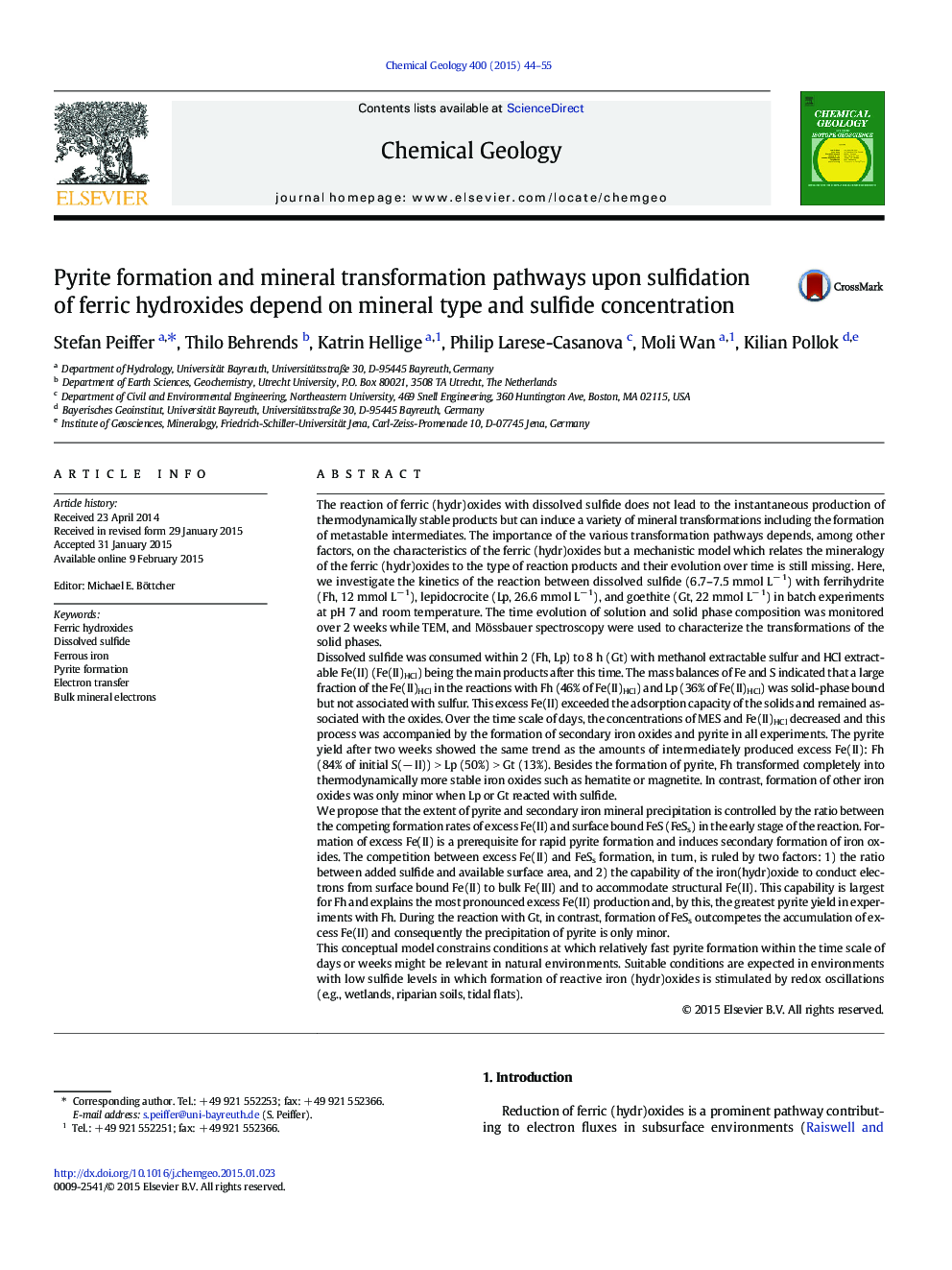| کد مقاله | کد نشریه | سال انتشار | مقاله انگلیسی | نسخه تمام متن |
|---|---|---|---|---|
| 4698563 | 1637573 | 2015 | 12 صفحه PDF | دانلود رایگان |
• Sulfidation proceeds at different rates (ferrihydrite > lepidocrocite > goethite).
• Formation of FeS (hours) and pyrite (weeks) is decoupled in time.
• Rate and yield of pyrite formation decreases with Fh > Lp > Gt.
• A pathway for heterogeneous pyrite formation is proposed.
The reaction of ferric (hydr)oxides with dissolved sulfide does not lead to the instantaneous production of thermodynamically stable products but can induce a variety of mineral transformations including the formation of metastable intermediates. The importance of the various transformation pathways depends, among other factors, on the characteristics of the ferric (hydr)oxides but a mechanistic model which relates the mineralogy of the ferric (hydr)oxides to the type of reaction products and their evolution over time is still missing. Here, we investigate the kinetics of the reaction between dissolved sulfide (6.7–7.5 mmol L− 1) with ferrihydrite (Fh, 12 mmol L− 1), lepidocrocite (Lp, 26.6 mmol L− 1), and goethite (Gt, 22 mmol L− 1) in batch experiments at pH 7 and room temperature. The time evolution of solution and solid phase composition was monitored over 2 weeks while TEM, and Mössbauer spectroscopy were used to characterize the transformations of the solid phases.Dissolved sulfide was consumed within 2 (Fh, Lp) to 8 h (Gt) with methanol extractable sulfur and HCl extractable Fe(II) (Fe(II)HCl) being the main products after this time. The mass balances of Fe and S indicated that a large fraction of the Fe(II)HCl in the reactions with Fh (46% of Fe(II)HCl) and Lp (36% of Fe(II)HCl) was solid-phase bound but not associated with sulfur. This excess Fe(II) exceeded the adsorption capacity of the solids and remained associated with the oxides. Over the time scale of days, the concentrations of MES and Fe(II)HCl decreased and this process was accompanied by the formation of secondary iron oxides and pyrite in all experiments. The pyrite yield after two weeks showed the same trend as the amounts of intermediately produced excess Fe(II): Fh (84% of initial S(− II)) > Lp (50%) > Gt (13%). Besides the formation of pyrite, Fh transformed completely into thermodynamically more stable iron oxides such as hematite or magnetite. In contrast, formation of other iron oxides was only minor when Lp or Gt reacted with sulfide.We propose that the extent of pyrite and secondary iron mineral precipitation is controlled by the ratio between the competing formation rates of excess Fe(II) and surface bound FeS (FeSs) in the early stage of the reaction. Formation of excess Fe(II) is a prerequisite for rapid pyrite formation and induces secondary formation of iron oxides. The competition between excess Fe(II) and FeSs formation, in turn, is ruled by two factors: 1) the ratio between added sulfide and available surface area, and 2) the capability of the iron(hydr)oxide to conduct electrons from surface bound Fe(II) to bulk Fe(III) and to accommodate structural Fe(II). This capability is largest for Fh and explains the most pronounced excess Fe(II) production and, by this, the greatest pyrite yield in experiments with Fh. During the reaction with Gt, in contrast, formation of FeSs outcompetes the accumulation of excess Fe(II) and consequently the precipitation of pyrite is only minor.This conceptual model constrains conditions at which relatively fast pyrite formation within the time scale of days or weeks might be relevant in natural environments. Suitable conditions are expected in environments with low sulfide levels in which formation of reactive iron (hydr)oxides is stimulated by redox oscillations (e.g., wetlands, riparian soils, tidal flats).
Journal: Chemical Geology - Volume 400, 14 April 2015, Pages 44–55
